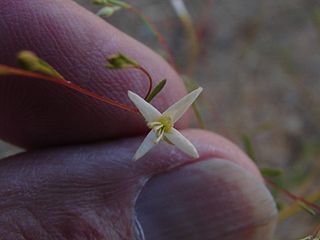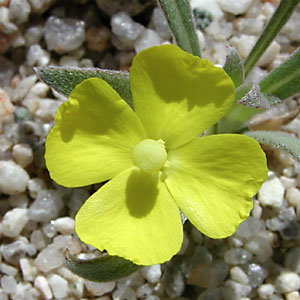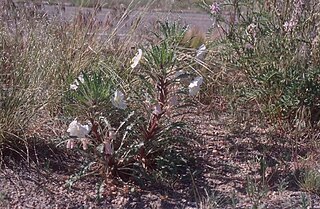
Oenothera caespitosa, known commonly as tufted evening primrose, desert evening primrose, rock-rose evening primrose, or fragrant evening primrose, is a perennial plant of the genus Oenothera native to much of western and central North America. It produces a rosette of lobed or toothed leaves each up to 36 centimeters long around a woody caudex. It is normally night-blooming.

Gayophytum diffusum is a species of flowering plant in the evening primrose family known by the common name spreading groundsmoke. It is native to western North America where it is a common member of many different habitats. This is a spindly, branching annual herb reaching a maximum height of about half a meter. Its thin stems have sparse narrow leaves a few centimeters long. The occasional flowers are petite and usually white in color. The fruit is a cylindrical, knobby capsule up to 1.5 centimeters long.

Camissoniopsis micrantha is a species of flowering plant in the evening primrose family known by the common name miniature suncup. It is endemic to California, where it grows along the coast and in the coastal mountains as far north as the San Francisco Bay Area, as well as in the Central Valley. It grows in sandy areas in a number of habitats, from beaches to inland slopes. This is a small, hairy annual herb producing a basal rosette of leaves. The stem varies in morphology, approaching half a meter in erect height or quite short and flat, with or without branching. The larger leaves are located in the basal rosette; those on the stem are narrow and shorter. The inflorescence produces bears a number of flowers with petals less than 5 millimeters long. They are bright yellow and dry to a reddish color as they close. If the inflorescence is located on an erect stem it bends the stem over with its weight. The flowers self-pollinate. The fruit is a cylindrical capsule 1 to 2 centimeters long.

Camissoniopsis bistorta is a species of flowering plant in the evening primrose family known by the common names southern suncup and California suncup. It is native to southern California and Baja California, where it grows in several types of plant community along the coast and in the coastal hills and mountain ranges. This is a hairy annual or perennial herb spreading from a basal rosette with stems reaching up to 80 centimeters long. Leaves are lance-shaped to narrowly arrowhead-shaped and sometimes toothed, and 1 to 12 centimeters in length. Toward the end of the spreading stems are nodding inflorescences of flowers, each flower with four bright yellow petals dotted with red at their bases. At the center are stamens and a protruding, nearly spherical stigma. The fruit is a straight or slightly coiled capsule up to 4 centimeters long.
Chylismia heterochroma is a species of evening primrose known by the common name Shockley's evening primrose. It is native to the desert slopes and woodland of eastern California and Nevada. It is a hairy, glandular annual herb growing a spindly stem up to a meter tall. There is a thick basal rosette of leaves which are mostly oval in shape and several centimeters in length, and generally no leaves higher up the stem. The inflorescence produces several small flowers with four oval petals just a few millimeters long and lavender in color with yellow-tinted bases. The fruit is a club-shaped capsule roughly a centimeter long.

Camissoniopsis hirtella is a species of evening primrose known by the common name Santa Cruz Island suncup. It is native to California and Baja California, where it grows on the slopes of coastal and inland hills and mountains, especially in areas that have recently burned. It is an annual herb producing a hairy stem up to about half a meter in height. Most of the leaves are located in a basal rosette at ground level and are oval in shape and a few centimeters in length. The nodding inflorescence produces flowers with sepals coated in long, glandular hairs, and bright yellow petals under a centimeter long each. The petals sometimes have red dots at their bases. The fruit is a coiling capsule up to 2 centimeters long.
Camissoniopsis intermedia is a species of evening primrose known by the common name intermediate suncup. It is native to California and Baja California, where it grows on the slopes of coastal and inland hills and mountains, especially in areas that have recently burned. It is an annual herb producing an erect, hairy stem up to about half a meter in height. Most of the leaves are located in a basal rosette at ground level and are oval to lance-shaped and up to 12 centimeters in length. The hairy, nodding inflorescence produces flowers with yellow petals just a few millimeters in length. The petals have one or two red dots at their bases. The fruit is a straight or coiling, wormlike capsule up to 2.5 centimeters long.

Camissoniopsis lewisii is a species of evening primrose known by the common name Lewis' evening primrose. It is native to southern California and Baja California, where it grows in coastal habitat and on the grasslands of the inland mountain ranges. as an example occurrence in Baja California, C. lewisii occurs in association with Mimulus aridus and Adiantum jordanii.
Camissoniopsis luciae is a species of evening primrose known by the common name Santa Lucia suncup. It is endemic to California, where it grows in the mountains of the Central Coast, mainly in chaparral habitat. It is a hairy annual herb producing an erect stem up to half a meter tall from a basal rosette. The hairy leaves have lightly toothed edges and are up to about 5 centimeters long. The nodding inflorescence produces flowers with yellow petals a few millimeters long with red markings near the bases. The fruit is a straight or coiling capsule.

Camissoniopsis pallida is a low growing, yellow-flowered annual plant in the evening primrose family, Onagraceae. It is known by the common names pale primrose or pale yellow suncup. It is native to the desert and scrub habitat of the region where Arizona, California, and Nevada meet. It is a roughly hairy annual herb growing in a low patch on the ground, sometimes producing an erect stem from the basal rosette. The herbage is gray-green to reddish green. The leaves are lance-shaped and up to 3 centimeters long. The nodding inflorescence produces flowers with yellow petals 2 to 13 millimeters long, each with small red markings near the bases. The fruit is a straight to tightly coiled capsule.

Camissonia parvula is a species of evening primrose known by the common name Lewis River suncup. It is native to the Great Basin of the United States. It grows in sagebrush, woodland, and other Great Basin habitat. It is a slender annual herb producing a wiry erect stem 15 to 30 centimeters in maximum height. The leaves are linear in shape and 1 to 3 centimeters long. They are located along the stem as there is no basal rosette. The nodding inflorescence produces flowers with yellow petals only 2 or 3 millimeters long. The fruit is a capsule 2 to 3 centimeters long, swollen with seeds, and sometimes coiling.
Epilobium halleanum is a species of flowering plant in the evening primrose family known by the common name glandular willowherb. It is native to parts of western North America from British Columbia to New Mexico, where it grows in many types of habitat. It is an erect perennial herb growing up to about half a meter tall. The leaves are oval in shape low on the stem and narrower and somewhat lance-shaped higher, the longest about 4.5 centimeters long. The inflorescence is a raceme of glandular flowers, each with four notched white to pink petals a few millimeters long. The fruit is an elongated capsule up to 6 centimeters long.
Epilobium pallidum is a species of flowering plant in the evening primrose family known by the common name largeflower spike-primrose. It is native to western United States, where it grows in moist areas in northern California, Oregon, and Idaho. It is an annual herb producing a narrow, upright stem up to 60 centimeters long lined with narrow oval leaves each up to 5 centimeters in length. The inflorescence atop the stem bears several flowers and hairy, leaflike bracts. Each flower has four bilobed petals each up to about a centimeter long and bright pink in color. The fruit is a beaked capsule between 1 and 2 centimeters long containing a row of tiny seeds.
Epilobium torreyi is a species of flowering plant in the evening primrose family known by the common names Torrey's willowherb and brook spike-primrose. It is native to western North America from British Columbia to California, where it grows in many types of habitat, often in moist areas. It is a hairy annual herb producing a narrow, upright stem often exceeding half a meter tall lined with narrow lance-shaped leaves. The hairy, glandular inflorescence bears tiny white or pink flowers. They are usually cleistogamous, remaining closed and self-pollinating. The fruit is a capsule up to about a centimeter long.

Oenothera californica, known by the common name California evening primrose, is a species of flowering plant in the evening primrose family.

Oenothera laciniata is a species of flowering plant in the evening primrose family known by the common name cutleaf evening primrose. It is native to the eastern United States but it can be found in many other places as an introduced species and sometimes a noxious weed. It is reported from Hawaii, Australia, Britain, France, Korea, Japan, and other areas. This is an annual or short-lived perennial herb producing a spreading stem from a hairy rosette of deeply cut or lobed leaves. Flowers occur in the axils of leaves higher on the stem. Each flower has pale to deep yellow petals up to about 2 centimeters long which fade orange, pink, or red with age. The fruit is a cylindrical capsule up to 5 centimeters in length.

Oenothera primiveris is a species of flowering plant in the evening primrose family known by the common names yellow desert evening primrose, bottle evening-primrose, and desert evening-primrose.

Oenothera wolfii is a rare species of flowering plant in the evening primrose family known by the common name Wolf's evening primrose. It is native to the coastline of southern Oregon and northern California, where it grows in coastal prairie, dunes, and coastal forest and woodland habitat. As of 1997 it was known from only about 16 occurrences. The biggest threat to the plant is its easy hybridization with its relative and probable descendant, Oenothera glazioviana. As this rare wild plant crosses with the introduced garden escapee, introgression occurs, causing what is known as genetic pollution; fewer pure individuals of O. wolfii will be seen as they are outnumbered by hybrids.
Oenothera xylocarpa is a species of flowering plant in the evening primrose family known by the common name woodyfruit evening primrose. It is native to the Sierra Nevada of California, its range extending just into western Nevada. It grows in coniferous forest and meadow habitat, often in soils rich in pumice and other gravel. It is a perennial herb growing from a thick taproot and producing a flat, dense rosette of hairy, gray-green leaves. There is no stem. The showy flowers appear amidst the leaves. Each has four petals which may be nearly 4 centimeters long, bright yellow in color, fading pink to red with age. The fruit is a straight, curving, or twisting capsule which may be up to 9 centimeters long.

Oenothera harringtonii is a species of flowering plant in the evening primrose family known by the common names Arkansas Valley evening primrose and Colorado Springs evening primrose. It is endemic to the state of Colorado in the United States.













